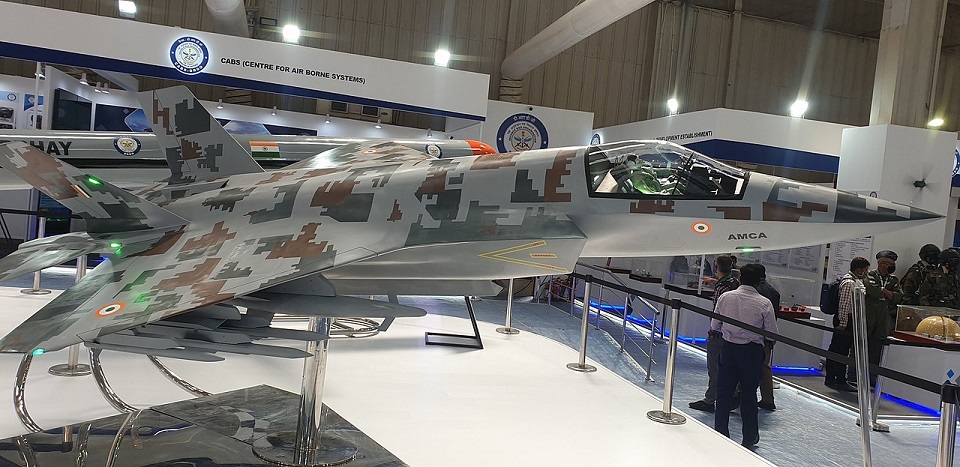Aviation
General Electric Ready to Develop New Engine for India’s 5th Gen AMCA

In a significant development for India’s Advanced Medium Combat Aircraft (AMCA) program, General Electric (GE) Aerospace CEO Amy Gowder has announced the company’s willingness to design and build a clean-slate engine specifically for the fighter jet’s AMCA MkII variant. This marks a crucial step in India’s pursuit of self-reliance in high-thrust engine technology, elevating its aeronautical capabilities.
Gowder emphasized that the technology transfer to Hindustan Aeronautics Limited (HAL) would surpass previous partnerships, with options for exporting engines and components from India.
The collaboration between GE and HAL began with a memorandum of understanding signed in Washington, involving the production of 99 F414 engines for India’s light combat aircraft (LCA) TEJAS MK-2 program. With an estimated value of around $1 billion, the deal encompasses an impressive 80% transfer of technology (ToT). covering crucial aspects such as coating for the hot end of the engine, crystal blades, and laser drilling technology.
These engines are intended to power the Mk2 version of the Light Combat Aircraft and initial batches of the AMCA. GE’s involvement in the joint production aims to bridge a technology gap, lay the groundwork for larger jet engine development, and potentially open doors for exports.
As the process of manufacturing GE Aviation’s F414 INS6 engines in India is underway, Gowder outlined plans to formalize the agreement with HAL and the government, with co-production set to commence this year.
This announcement aligns with India’s decision to initially acquire two squadrons of AMCA MkI jets equipped with the F414 INS6, followed by the AMCA MkII variant featuring a high-thrust engine capable of generating 110-120kN of thrust. Successfully achieving this goal not only enhances India’s air dominance but also positions the nation as a major player in the global aerospace market.
The AMCA necessitates a significantly more robust engine, especially following the completion of final testing. Given the stealth features incorporated into the aircraft, its overall capacity is greatly dependent on both the engine and avionics technology.
The AMCA (Advanced Medium Combat Aircraft) will feature a modern cockpit with a large touchscreen display for easy interaction, a vertical multi-function display, and a holographic head-up display for the pilot. The design includes a hands-on throttle-and-stick setup, with the right hand on the stick and the left hand on the throttle, to make it easier for the pilot to control.
As of February 2023, the DRDO has finished designing the AMCA and is now awaiting a “Critical Design Review,” which is a detailed technical evaluation to ensure that the aircraft system is ready for manufacturing, testing, and meets performance requirements.

Aviation
COMAC Unveils Plans for the C929 to Rival Airbus and Boeing

After the success of China’s first C919 aircraft, the country is setting its sights on developing a larger plane. COMAC (Commercial Aircraft Corporation of China) has officially confirmed plans to build a widebody aircraft, marking a significant step in its aircraft lineup.
Traditionally, Airbus and Boeing dominate the widebody aircraft market, with decades of expertise in developing planes and engines capable of carrying heavy payloads. China, which currently relies on imported engines, is now aiming to challenge these giants with its own widebody jet, the C929, designed to compete with the Airbus A350 and Boeing 777.
American Airlines Is Looking for Flight Attendants: Apply Now
The C929 will be China’s first independently developed long-range widebody aircraft. It adheres to international airworthiness standards and boasts independent intellectual property rights. The baseline version is designed to seat 280 passengers and offers a range of 12,000 kilometers, catering to global demand for both regional and international air travel.
Russia, which also needs reliable narrowbody and widebody aircraft, could become a key customer for the C929. Additionally, China plans to target the broader Asian market as it continues to expand its aviation capabilities.
Close Call at Heathrow: BA Flight Narrowly Escapes Drone Collision
China’s aviation progress includes the ARJ21 (now called C909), a regional jet with 100 seats for shorter routes, and the C919, a narrowbody jet with 180 seats designed to rival the Boeing 737 MAX and Airbus A320. Both models have found increasing demand in the domestic market.
At China’s largest air show in Zhuhai, COMAC announced that Air China will be the launch customer for the C929 widebody jet, though details about order size and delivery timelines were not disclosed.
Other major deals announced by COMAC include:
- Hainan Airlines: Firm orders for 60 C919 and 40 C909 regional jets.
- Colorful Guizhou Airlines: 30 C909 jets, with 20 firm orders and 10 provisional agreements.
The C929, renamed from the CR929 after Russia withdrew from the joint development project in 2023, is expected to carry 280–400 passengers with a range of 12,000 kilometers, competing directly with Boeing’s 787 Dreamliner.
According to COMAC’s deputy general manager, Tong Yu, the first fuselage section of the C929 is expected by September 2027, with prototype test flights anticipated soon after.
-

 Aviation2 months ago
Aviation2 months agoMicrosoft Flight Simulator Raises $3 Million to Bring Back the An-225 Mriya
-

 Airlines2 months ago
Airlines2 months agoQantas Engineers Stage Walkout Over Cost of Living Concerns
-

 Airlines2 months ago
Airlines2 months agoQatar Citizens Can Travel to the United States Without a Visa
-

 Aviation2 months ago
Aviation2 months agoQatar Airways bans these new Electronic Devices on plane
-

 Airlines2 months ago
Airlines2 months agoJapan Airlines Rolls Out Free Domestic Flights to International Passengers
-

 Defence2 months ago
Defence2 months agoWhich Country Has the Largest Fleet of Fighter Aircraft?
-

 Airport2 months ago
Airport2 months agoWestern Sydney Airport Welcomes Its First Plane After 6 Years of construction
-

 Aviation2 months ago
Aviation2 months agoDid you know ? Once Boeing 747 carried 1088 passenger in 1991








